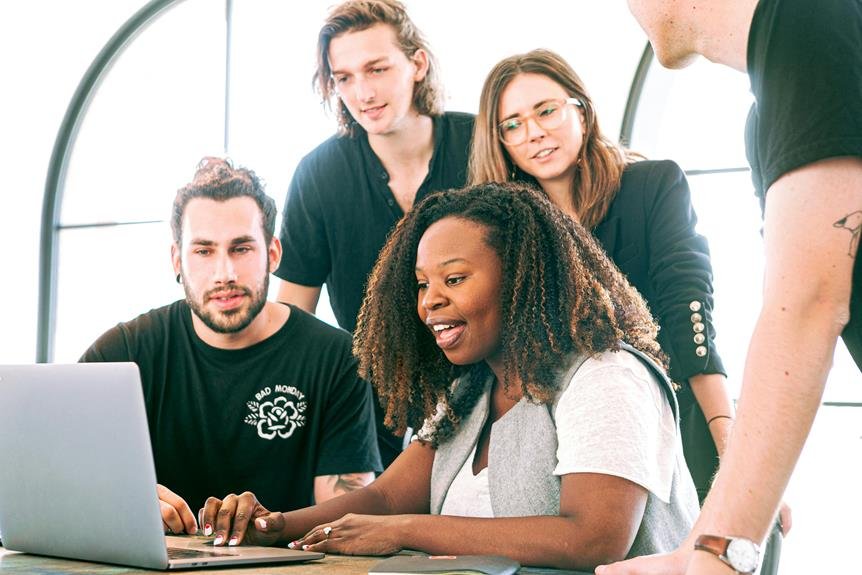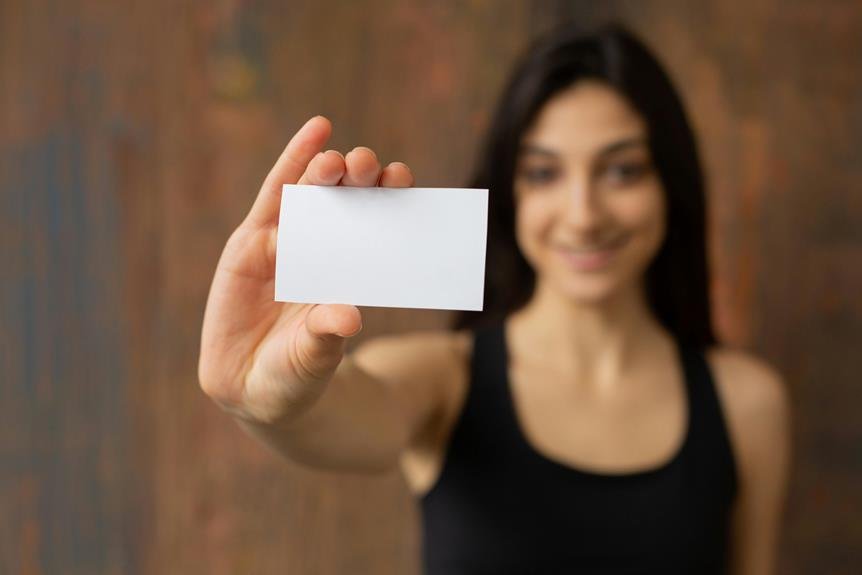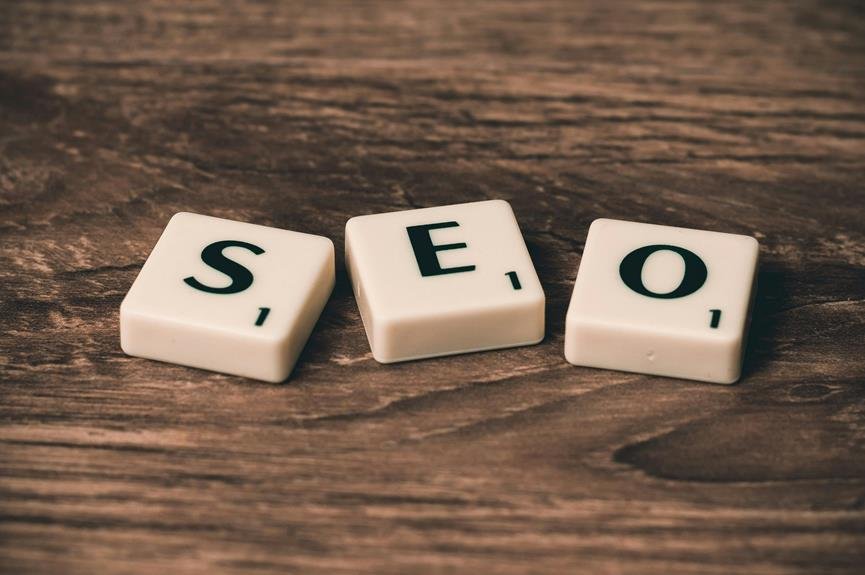To leverage AI art in your creative marketing campaigns, start by exploring various styles that resonate with your brand. Utilize AI to create unique visuals that enhance your storytelling and engage your audience. Select the right tools based on your needs and budget, ensuring they integrate smoothly with your existing systems. Don't forget to personalize your content to align with current trends, boosting relevance. Keeping ethical considerations in mind is vital for transparency. By measuring audience feedback and engagement metrics, you can refine your approach and maximize impact, setting the stage for innovative strategies that are just ahead.
Understanding AI Art
AI art is revolutionizing the way we think about creativity and design. As you immerse yourself in this enchanting world, you'll discover a range of AI art techniques that empower artists and designers alike. These techniques harness the power of algorithms and machine learning to produce stunning visuals that often challenge traditional notions of creative expression.
Imagine using AI tools that can analyze existing art styles and generate unique pieces in mere moments. You can experiment with different styles, colors, and forms, allowing your imagination to run wild. This isn't just about creating stunning images; it's about expanding the boundaries of what art can be.
With AI art at your fingertips, you'll find new ways to express yourself and communicate ideas. Whether you're a seasoned professional or just starting out, you can incorporate AI into your creative toolkit, enhancing your projects in unexpected ways.
The blend of technology and artistry offers an exciting playground for exploration. By understanding AI art, you're not only embracing new techniques but also redefining what it means to be creative in today's digital age. So, leap into and explore the endless possibilities that AI art has to offer!
Benefits of AI Art in Marketing
Harnessing the power of AI art in marketing can transform your campaigns in remarkable ways. By integrating AI-generated visuals, you can tap into creative inspiration that enhances your brand identity. These unique aesthetics set you apart from the competition, allowing you to craft innovative concepts that resonate with your audience.
Consider the following benefits of AI art in your marketing strategy:
- Cost Efficiency: AI art can considerably reduce production costs while maintaining high-quality visuals.
- Audience Engagement: Visual storytelling through AI art captures attention and fosters deeper connections with your audience.
- Personalization Options: Tailor your visuals to align with trends, making your campaigns more relevant and appealing.
With AI art, you can achieve trend alignment, ensuring your content feels fresh and timely. This not only boosts audience engagement but also gives you a competitive advantage in a crowded market. By leveraging AI's capabilities, you're equipped to create compelling marketing campaigns that effectively communicate your brand's message. Ultimately, embracing AI art opens doors to endless possibilities, making your marketing efforts not just effective, but also truly memorable.
Choosing the Right AI Tools
When choosing the right AI tools for your marketing campaigns, start by evaluating your specific needs. Compare the features of different tools to see which ones align best with your goals and capabilities. Don't forget to reflect on your budget, as the right tool should provide value without breaking the bank.
Assessing Your Needs
Before diving into AI tools, it's crucial to evaluate your specific needs and objectives. Understanding your creative objectives and knowing your target audience will help you choose the right AI art tools that align with your marketing strategy. Here's what you should consider:
- What are your creative goals? Identify whether you aim to enhance brand awareness, boost engagement, or create shareable content.
- Who's your target audience? Define the demographics and preferences of the people you want to reach. Knowing their interests can guide your AI tool selection.
- What's your budget? Determine how much you're willing to invest in AI art tools, as costs can vary considerably.
Once you clarify these aspects, you'll be better equipped to select tools that not only meet your creative objectives but also resonate with your audience. Remember, the right AI tool can enhance your marketing campaigns, making them more visually appealing and effective. By taking the time to assess your needs upfront, you set the foundation for a successful and impactful marketing strategy that leverages the power of AI art.
Tool Features Comparison
Selecting the right AI tools for your marketing campaigns can greatly enhance your creative output and effectiveness. To make an informed choice, start by conducting thorough tool comparisons. Look closely at tool capabilities and feature analysis to identify which options best suit your specific needs.
Consider user experiences, as they often provide insights into how intuitive a tool is and its overall performance metrics. Tools that boast high accessibility can be essential, especially if your team has varying levels of technical skills. Also, pay attention to software compatibility, ensuring the AI tool integrates smoothly with your existing systems.
When evaluating creative applications, think about what type of art you'll be generating and how each tool aligns with your vision. Some tools excel in generating visuals, while others may focus on enhancing existing artwork. By understanding these distinctions, you can better assess which tools will provide the most value for your campaigns.
Ultimately, by prioritizing these factors in your decision-making process, you'll be better equipped to choose the right AI tools that not only meet your marketing goals but also inspire your creative journey.
Budget Considerations
Budgeting for AI tools is essential to guarantee you get the most bang for your buck without compromising on quality. To make informed decisions, you need to conduct a thorough cost analysis and consider various pricing models. This way, you can allocate your budget effectively and ascertain resource optimization.
Here are three key aspects to focus on:
- Expense Tracking: Keep a close eye on your spending to identify any unexpected costs and adjust your budget accordingly.
- Funding Strategies: Explore different funding options, such as grants or partnerships, to enhance your financial planning.
- ROI Evaluation: Regularly assess the return on investment for each AI tool you use, helping you understand which solutions provide the best value.
Integrating AI Art Into Campaigns
Incorporating AI art into your marketing campaigns can elevate your brand's visual storytelling in innovative ways. By harnessing various AI art styles, you can craft unique visuals that resonate with your audience. This creative collaboration between human input and AI technology enables content customization that aligns perfectly with your brand identity.
To engage your audience effectively, reflect on how different AI art styles can enhance your messaging. The following table highlights key aspects to ponder when integrating AI art into your campaigns:
| Aspect | Considerations |
|---|---|
| AI Art Styles | Explore diverse styles that reflect your brand's voice. |
| Audience Engagement | Use interactive AI art to invite feedback and participation. |
| Ethical Considerations | Be transparent about AI use and respect copyright laws. |
| Trend Forecasting | Stay ahead by incorporating current trends in AI art. |
Case Studies of Successful Use
Many brands have turned to AI art and reaped impressive rewards in their marketing efforts. By embracing innovative strategies, these companies have crafted successful campaigns that resonate with their audiences. Here are a few standout examples:
- Coca-Cola: They launched a campaign that utilized AI-generated artwork to create unique, limited-edition cans. This not only attracted attention but also engaged consumers in a fresh and exciting way.
- Nike: In a recent launch, Nike used AI art to design custom sneaker patterns. This approach allowed fans to visualize their unique creations, boosting engagement and driving sales.
- Spotify: The music streaming giant employed AI art in their advertising, crafting visually striking playlists that captured user interest and enhanced brand identity.
These examples illustrate how leveraging AI art can elevate your marketing initiatives. By integrating such creative elements, you not only stand out in a crowded market but also foster a deeper connection with your audience. As you explore AI art, consider how these successful campaigns can inspire your own innovative strategies for growth and engagement.
Best Practices for Implementation
When implementing AI art in your marketing campaigns, it's crucial to follow best practices that can maximize its impact. Start by considering ethical considerations and copyright issues. Make certain you have the rights to use the AI-generated images and that they align with your brand's values. This helps maintain audience trust and avoids potential legal troubles.
Next, think about audience perception. Understand how your target demographic views AI art and adjust your approach accordingly. Engage in creative collaboration with designers and artists to guarantee that the AI-generated content complements your content strategy. This teamwork can enhance the quality of visual storytelling, making your message more relatable and impactful.
Also, prioritize brand alignment. Ascertain that the AI art reflects your brand's identity and maintains design consistency across all platforms. This consistency helps reinforce your brand message and creates a recognizable presence in the market.
Measuring Impact and Engagement
Measuring the impact and engagement of AI art in your marketing campaigns is essential for understanding its effectiveness. By analyzing various engagement metrics, you can gain valuable insights into how your audience interacts with your visual storytelling. This process allows you to evaluate content performance and refine your strategies for better results.
Consider these key aspects when measuring impact:
- Audience feedback: Gather opinions and reactions from your target demographic to understand their perception of your brand.
- Conversion rates: Track how AI art influences customer actions, such as signing up for newsletters or making purchases.
- Social media impact: Monitor likes, shares, and comments to gauge how well your campaign resonates online.
Together, these elements inform your overall campaign effectiveness. By focusing on brand perception and utilizing AI art strategically, you can elevate your marketing efforts. Ultimately, you'll create a more engaging experience that not only captures attention but also drives results. Remember, the goal is to connect with your audience and inspire them to take action, so keep an eye on these metrics to continuously improve your campaigns.
Future Trends in AI Art
As you look toward the future of AI art, you'll notice exciting new styles emerging that can reshape your marketing approach. These innovative art forms not only capture attention but also integrate seamlessly with the latest marketing tools, enhancing your campaigns. By staying ahead of these trends, you can create compelling visuals that resonate with your audience and elevate your brand.
Emerging AI Art Styles
Innovation drives the evolution of AI art styles, opening up exciting possibilities for creators and marketers alike. As technology advances, you'll see the emergence of unique styles that can enhance your campaigns. Among these trends, digital surrealism stands out, blending dreamlike imagery with vibrant colors, making your visuals unforgettable. Generative portraits are also gaining traction, allowing you to create lifelike representations of characters or products through advanced algorithms.
Consider integrating these emerging styles into your marketing strategies:
- Abstract algorithms: These can transform simple data into stunning visuals, grabbing attention.
- Style transfer: This technique enables you to apply the essence of one artwork to another, creating a unique visual narrative.
- Interactive visuals: Engaging your audience through interactive elements can foster deeper connections and enhance brand loyalty.
With tools like text to image and 3D rendering, you can push boundaries and craft experiences that resonate with your audience. As you explore these emerging AI art styles, remember that embracing innovation can set you apart in a crowded market and create memorable campaigns that leave a lasting impression.
Integration With Marketing Tools
The integration of AI art with marketing tools is reshaping how brands connect with their audiences. By leveraging AI tools, you can enhance your marketing strategies through creative collaboration, allowing teams to brainstorm and visualize ideas more effectively. This synergy transforms visual storytelling, making your messages resonate deeply with potential customers.
With design automation, you can streamline the creation of compelling visuals that align with your brand identity. This not only saves time but also guarantees consistency in campaign aesthetics. Content customization becomes effortless, allowing you to tailor your visuals to different audience segments, which boosts audience engagement.
Moreover, harnessing trend analysis can provide insights into what resonates with your target market. By staying ahead of these trends, you can create art that speaks directly to current consumer interests. The result? A more effective marketing campaign that captures attention and drives action.
As you explore the integration of AI art with your marketing tools, remember that it's not just about the visuals; it's about crafting a narrative that connects, engages, and inspires your audience. Embrace this innovative approach to elevate your campaigns and achieve impactful results.
Overcoming Challenges and Concerns
Steering through the landscape of AI art in marketing can present a few challenges, but addressing these concerns head-on is essential for success. You'll need to navigate ethical implications and copyright concerns that arise when using AI-generated content. It's critical to maintain quality control to guarantee your audience perceives your brand as credible and authentic.
Consider these common challenges:
- Technological limitations: AI tools may not always produce the desired artistic style or quality, so you'll need to experiment and refine your approach.
- Skill gaps: If your team lacks experience with AI art, it can hinder your marketing efforts. Investing in training or hiring skilled professionals can help bridge this gap.
- Accessibility issues: Not everyone has access to the latest technologies, which could limit your reach and impact.
Conclusion
Incorporating AI art into your marketing campaigns can be like adding a splash of color to a black-and-white photo—transformative and eye-catching. By understanding the tools and strategies available, you can craft unique visuals that captivate your audience. As you embrace this innovative approach, remember to measure your impact and stay ahead of trends. With creativity as your canvas, the possibilities are endless, and your campaigns can truly stand out in a crowded marketplace.





Leave a Reply